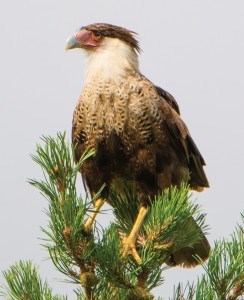
A crested caracara was spotted for the first time in Jasper National Park in mid-July, sending the birding world into a flutter.
The positive identification was made by Dale Wilde, a tourist from Columbus, Ohio, who captured several photos of the bird of prey as it sat perched on top of a pine tree near Snaring Road and Highway 16.
“It was exciting,” said Wilde, who had been vacationing in Montana before driving up through Kootenay and Yoho national parks and visiting Jasper.
According to Wilde, she was driving towards Jasper on Highway 16 July 16 when she saw a large bird sitting on top of a pine tree about 50 metres away. Instantly she knew it was a crested caracara—the first ever recorded in Alberta.
“I had just seen them two weeks prior in Florida, so I knew exactly what it was when I got out of the car,” she said.
Ecstatic about her unexpected sighting, she pulled over and flagged down a bus full of tourists that was lumbering along Snaring Road.
The driver of that bus happened to be Joe Urie, owner of Jasper Tour Company, who said he had seen the same bird two days earlier.
After pulling the bus over, Wilde had barely introduced herself before blurting out that she had spotted a crested caracara.
“I flipped out and was like, where is it? Because now I wouldn’t be the laughing stock around the water cooler at Parks Canada’s biology department,” said Urie, explaining he had reported it to Parks the day before.
“It was a huge, huge deal for her,” said Urie. “I may have been the first to spot it, but she was the one who positively ID’d it on the spot.”
Mark Bradley, a wildlife biologist with Parks, confirmed the sighting of the bird and identified it as a juvenile based on its mottled plumage and pink cere. Adults have black feathers and a yellow/orange cere.
Recognizing the significance of her discovery, Wilde contacted a friend on Facebook who put her in touch with Christian Artuso, the Manitoba program manager for Birds Studies Canada.
“She actually sent me a Facebook friend request with a message and a photo so I opened the photo and sure enough she was right it was a crested caracara,” said Artuso.
Eager to help spread the news, Artuso quickly shared the photo and information on several Facebook groups, including Alberta Birds.
“Of course people were skeptical at first, but multiple photographs started surfacing,” recalled Artuso.
On July 23, Wilde officially submitted an unusual bird sighting report to the Alberta Bird Record Committee at the Alberta Royal Museum. By Aug. 6 the record was officially accepted as the province’s first crested caracara.
Despite the fact it was the first time it was spotted in Alberta, Artuso said he wasn’t completely surprised by the report.
“It’s obviously way out of its range, but it didn’t surprise me completely because I had heard of another bird in Nanaimo, B.C.
“They vagrant up the east coast and up the west coast. There are records in the Seattle area and eastern Washington State and this one seemed to fit that pattern,” he said, adding in 2013 there were also a number of sightings on the east coast.
The northern extent of their range is usually southern Texas and Florida and the bird is found throughout Mexico and Central America.
“They are scavengers and are known to show up in weird places. There’s something in their evolution that enables them to disperse widely to take advantage of either opportunities or respond to conditions,” said Artuso, suggesting the dry conditions in the southwestern United States may be why they have been spotted so far north this year.
“It may be quite severe in the western part of their range in Arizona, so much so that some birds are starting to wander,” he said, adding the bird in Nanaimo was different from the one spotted in Jasper.
According to several reports, the bird in Jasper was feeding on a carcass near the railroad tracks and has since left.
“It stayed in that area for a few days and it seemed once the carcass got depleted it moved on,” said Artuso.
He said it would be very difficult for a crested caracara to spend winter in Jasper and it would likely head south again.
“Vagrant birds can wander out of their range for unknown reasons. Regular sightings would have to be recorded in the park before wildlife biologists would investigate,” said Bradley.
Anyone who believes they may have spotted a rare bird should first visit the Alberta Bird Record Committee or the Royal Alberta Museum website and review the official list of birds.
Paul Clarke
[email protected]
